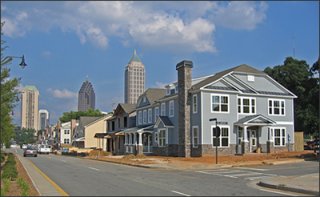Atlantic Station (Atlantic Steel Site Redevelopment Project)
In 2015, the Atlantic Station redevelopment transformed a 138-acre brownfield site into a dynamic, mixed-use neighborhood in the heart of Midtown Atlanta. This page describes the project and its results, and provides links to a case study and additional resources.
On this page:
Project Overview
Known for its live-work-play environment, the Atlantic Station neighborhood in Atlanta, Georgia embodies many smart growth principles and features a mix of uses, walkability, and accessibility. Housing opportunities range from affordable to upscale and include apartments, condominiums, single-family homes, detached homes, and lofts. Atlantic Station is also host to a variety of restaurants, stores, and a movie theater. Shops are near both housing and the 6 million square feet of development situated in mid-to- high-rise LEED-certified buildings. The multi-use development gives residents and workers a variety of transportation benefits, including shorter driving trips and the option of walking, biking, or taking transit.
History
Previously, the 138-acre neighborhood was the site of the former Atlantic Steel facility. Due to the industrial operations, the site was a brownfield and needed extensive cleanup and remediation. Further, a "business as usual" approach would not have allowed the Atlantic Station project to move forward. For adequate access, the plan required construction of a highway bridge to connect the site to both transit and the highway. Because Atlanta had not met Clean Air Act standards, the bridge (a form of highway construction) would have been prohibited under a standard interpretation of EPA regulations.
This obstacle was removed after an EPA analysis showed that the smart growth aspects of the redevelopment would help reduce air pollution, among other environmental benefits: cleanup of an old industrial property; separation of sanitary and storm sewer systems; reduction of auto emissions; and creation of jobs and economic development where infrastructure already existed.

The analysis, coupled with EPA's use of regulatory flexibility under an innovative program called Project XL, allowed the development to proceed. EPA's analytical work has been more broadly applied by EPA guidance allowing cities to take air quality credit for smart growth development.
The developer, Jacoby Development Corporation, worked intensively with EPA, the State of Georgia, local authorities and public stakeholders to develop a site-specific Project XL Agreement to enable the redevelopment to proceed. Stakeholders were engaged in the concept and rezoning process since the project began in early 1997. The Atlantic Station redevelopment officially opened in 2005, after several years of construction. The first residents moved into Atlantic Station in October 2003, and stores began opening in October 2005.
A Vibrant Success

Atlantic Station is now a vibrant and busy community with thousands of residents and workers. The bright yellow 17th Street Bridge, completed in 2004, crosses I-75 and I-85 and connects Atlantic Station to Midtown Atlanta. The bridge has four lanes of automobile traffic, with bicycles and transit sharing two of the four lanes. Pedestrians have wide sidewalks on each side of the bridge, with one side covered by a canopy. It is now home to more than 5,000 residents and 11 acres of public parks.
The Atlantic Station Access and Mobility Program (ASAP), which began in 2005, encourages residents and employees to walk, bike, take transit, or carpool. ASAP works to raise awareness of the benefits of alternate transportation modes and create incentives and promotional activities to encourage residents to live, work, and play on site. The program's successes include a shuttle service and ride-share.
These transportation options are helping people to drive less:
- According to data from 2008, the average vehicle miles traveled (VMT) for residents and employees of Atlantic Station is significantly lower than the rest of the region. The regional average VMT for individuals is about 34 miles per day. On average, Atlantic Station residents travel 14 miles per day, and employees working at Atlantic Station travel 12 miles.
- Furthermore, while single-occupancy vehicle trips constitute more than 60 percent of trips in the region, in Atlantic Station about half the trips made by residents and employees are in single-occupancy vehicles.
The Atlantic Station redevelopment also helped decrease runoff pollution, which improves watershed management and water quality. Because it was developed compactly, Atlantic Station used much less land than a conventional development with the same amount of housing and commercial space. This efficient land use reduced annual stormwater runoff by almost 20 million cubic feet a year.
In addition, Atlantic Station upgraded the sewer system that originally served the site by separating sanitary sewer from regular sewer and stormwater. This separated system, along with other inventive practices such as modified catch basins for stormwater control, will reduce the flow of pollutants from stormwater runoff to receiving bodies of water.
